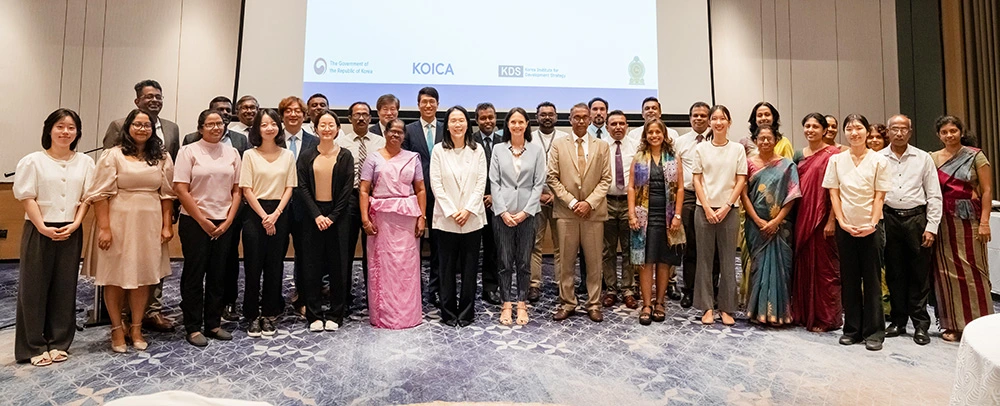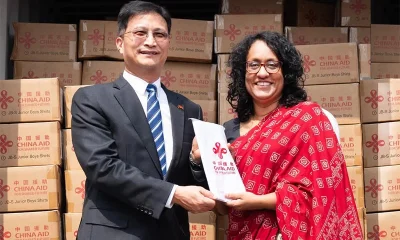News
Proposed action against wild animals: Minister Lalkantha has undermined NPP manifesto, says MONLAR

By Rathindra Kuruwita
Minister of Agriculture, Livestock, Lands, and Irrigation K. D. Lalkantha’s recent statement that there are no legal restrictions on taking measures against wildlife that damage crops on private agricultural lands encourages farmers to violate the law, says Sajeewa Chamikara of the Movement for Land and Agricultural Reform (MONLAR).
Chamikara noted that such remarks undermined the principles outlined in the government policy declaration “A Prosperous Country, A Beautiful Life,” which emphasises fostering responsible citizens, developing human resources, and upholding the rule of law. “This shows that government Ministers are disregarding these principles. The legislative power granted to the government by the people, after the defeat of corrupt and authoritarian regimes in the past, was not intended to enable breaches of agreements made with the public within such a short period,” Chamikara said.
Under Section 53A of the Fauna and Flora Protection Ordinance No. 02 of 1937, as last amended by Act No. 07 of 2022, the use of poisons, explosives, or intoxicants to kill or immobilise wild animals is strictly prohibited. Section 52 of the Act further makes it illegal to use artificial lighting to dazzle or lure animals or to act in a way that facilitates their capture.
“Additionally, Section 52A prohibits the use of food items, scents, colours, or any material or device to attract or entice animals for capture. Section 53A also forbids the possession of any animal killed or captured using poisons, explosives, or intoxicants,” Chamikara said.
According to Section 58, individuals guilty of such offences face penalties of fines between Rs. 15,000 and Rs. 30,000, imprisonment for one to two years, or both. Section 59 clarifies that anyone who attempts or abets the commission of these offences is equally culpable and subject to the same penalties.
Chamikara warned that if Minister Lalkantha’s suggestion to control wild animals on private agricultural lands like other agricultural pests is acted upon, it would result in direct violations of the Fauna and Flora Protection Ordinance, carrying severe penalties. “By encouraging farmers to engage in illegal activities, the Minister has effectively facilitated potential breaches of the law,” he said.
Under Section 59 of the Act, legal action could also be taken against Minister Lalkantha for abetting these offences. “Ignorance of the law is no excuse, a principle that applies equally to the Minister. Moreover, misleading farmers constitutes a significant injustice that warrants accountability,” he added.
Chamikara said that crop damage by wild animals is not only a legal fact but also common knowledge, and the underlying causes of this behaviour are well understood. “Wild animals have been forced into these situations due to human actions, such as the destruction and fragmentation of natural ecosystems for human settlements, commercial agricultural lands, and development projects. The introduction of non-native plantations like acacia, pine, eucalyptus, and teak, along with the spread of monoculture crops such as tea, rubber, coconut, oil palm, and maize, have exacerbated the issue. Additionally, invasive plants such as giant mimosa, lantana, and thorny creepers have proliferated in natural habitats, providing neither food nor shelter for wildlife,” he said.
These factors, Chamikara said, have caused species like monkeys, toque macaques, porcupines, wild boars, and peacocks to lose their habitats and foraging grounds, forcing them onto agricultural lands. He added that the reduction and fragmentation of natural habitats have also limited natural predators, leading to population increases in these species.
“In response, Schedule I of the Fauna and Flora Protection Ordinance designates certain mammals, including monkeys, toque macaques, wild boars, porcupines, and hares, as non-protected due to their status as agricultural pests. Similarly, Schedule III lists non-protected birds such as the Indian nightjar, crows, feral pigeons, spotted doves, and white-backed munias,” Chamikara said.
However, these animals and birds are deemed non-protected only within private agricultural lands. Even so, they cannot be controlled using chemicals, poisons, electrical traps, or intoxicants. Their control is permissible only through the use of a licensed firearm, as stipulated by law.
“To better address the issue of crop-damaging species, it is recommended that the Fauna and Flora Protection Ordinance be revised. Species like toque macaques and hares, which contribute minimally to crop damage, should be removed from Schedule I. Instead, more impactful species, such as toque langurs, should be included. Similarly, birds like feral pigeons and white-backed munias could be replaced with peacocks in Schedule III, as they contribute significantly to crop damage. This would ensure that the non-protected lists focus solely on species with substantial impact on agriculture,” Chamikara said.
News
Price revision: Rice retailers ask for grace period

By Rathindra Kuruwita
Rice retailers were in trouble following the sudden imposition of price controls, the President of the Marandagahamula Rice Traders’ Association, B.K. Ranjith, told a media briefing on Wednesday (11).
He said rice millers usually released rice at Rs 215 per kilo, which is then supplied to retailers through intermediaries who transport it to shops.
Ranjith noted that on 7 December, the government had set maximum retail prices for rice with a kilogram of white kekulu capped at Rs 220 a kilo, nadu at Rs 230 a kilo, and keeri samba at Rs 260 a kilo.
“We have been receiving rice at prices ranging from Rs 10 to Rs 25 above these controlled rates. We have requested officials to grant us a few days to sell off the existing stock purchased at higher prices. However, the Consumer Affairs Authority (CAA) began conducting raids on 10 December. Now, we are left with no option but to incur substantial losses,” he said.
News
Chinese grant: First batch of school uniform material arrives

Sri Lanka received the first shipment of fabric from the People’s Republic of China on Tuesday (10) as part of a larger grant to supply uniform materials for schoolchildren in 2025.
The fabric was officially handed over to Premier Dr. Harini Amarasuriya, who is also the Minister of Education, Higher Education, and Vocational Education, by Chinese Ambassador to Sri Lanka Qi Zhenhong during a ceremony at the Colombo Port.
The fabric will arrive in three shipments before the end of this year, with the first one now delivered.
Ambassador Qi noted that a total of 11.82 million meters of fabric, valued at approximately 5.2 billion Sri Lankan rupees (18 million U.S. dollars), will be provided.
In November, the Ambassador said the Chinese government would fully cover the cost of the fabric required for school uniforms for all public school students in Sri Lanka for the next school year, free of charge.
News
KOICA Pledges 65 million Dollars to Climate Change Mitigation in Sri Lanka

Korea International Cooperation Agency (KOICA) and the Government of Sri Lanka jointly endorsed the KOICA’s Climate Change Response Programme (CCRP) on Wednesday (11).
In a press release KOICA said it has been developing CCRP in collaboration with the Korea Institute of Development Strategy (KDS) since early 2024. The objective of CCRP is to ‘Promote the Transition to a Low-Carbon Society in Sri Lanka through Innovative, Sustainable, and Circular Approaches in Key Emission Reduction Sectors’. The launch event was graced by the participation of dignitaries representing a multitude organization, both from the Sri Lankan Government, Bi-Lateral and Multi-Lateral Development partners.
Below are excerpts of the press conference: “The proposed CCRP phase 1 is covering five years from 2026-2030 with an indicative budget worth 65 million USD. The CCRP is designed to effectively respond to Sri Lanka’s top climate priorities, serving as a guiding framework for project development and design in collaboration with the government. Additionally, it provides a platform for collaboration with other donor agencies, ensuring alignment towards shared strategic goals in combating climate change.
“The KOICA and KDS teams have been engaging in a collaborative consultation process involving the key stakeholders from multiple sectors related to the climate change avenue in Sri Lanka. The team engaged the Sri Lankan Government at both high and working levels during the programme development period by forming a Programme Management Steering Committee and sector-wise Project Development Committees. KOICA also held discussions with bilateral and multi-lateral international organizations who are active in the field to gauge the current donor engagement.
“The CCRP is in alignment with Sri Lanka’s current Climate Response Policies; Vision 2030, NDCs, and Carbon Net Zero 2050. Due consideration has also been given to the global trends in climate change when developing this programme. It identifies three main areas for intervention in Sri Lanka, namely; Renewable Energy, Sustainable Transport, and E Waste Management. Each sector’s current status major challenges have been detailed in the concept note.
“In its core, the team has modeled the programme around seeking solutions to three key problems across the areas identified, namely; the insufficient legal policy and institutional framework, limited knowledge and capacity in institutions and personnel, and lack of green infrastructure, technology, and syste
“The programme goes on to elaborate further on the possible means of interventions within KOICA’s implementation framework modalities including technical cooperation, grant projects as well as possible private sector engagement.
“During the launch, the Director Generals of the Departments of External Resources and National Planning and the Country Director of the KOICA Sri Lanka Office, all endorsed the programme.
“Sharing her remarks, KOICA Country Director- KIM Myung Jin stated that “The world is increasingly struggling with the impacts of rapid climate change, and Sri Lanka, unfortunately is highly vulnerable to it in support of its mitigation, KOICA Sri Lanka Office wants to undertake a pivotal role to mitigate climate crisis in Sri Lanka” The Country Director further remarked that they have supported Sri Lanka for 30 years and they want to pledge another 30 years of support to Sri Lanka”
“On behalf on the Government of Sri Lanka, The Additional Director General of the National Planning Department Y.P Sumanawathi thanked KOICA for their continued support to Sri Lanka. She also remarked that KOICA’s programme has identified crucial areas in the Sri Lankan climate change sector and that their integrated approach in addressing mitigation is exactly what Sri Lanka requires.
“Representing the leading Development partner in the field Deputy Country Representative of UNDP, Malin Herwig also addressed the gathering and remarked that they have recognized Sri Lanka’s needs and assured continued collaboration to KOICA in the implementation of the Climate Change Response Programme emphasizing that at the implementation stage, they will be able to complement KOICA’s effort at a greater level.
The CCRP will be endorsed by the participants of the Programme Management Steering Committee and will serve as the guidepost in KOICA’s aid to Sri Lanka in the upcoming cycles. “
-

 News3 days ago
News3 days agoSri Lanka’s first seven-star hotel ready for opening in 2025
-

 Business2 days ago
Business2 days agoLaunching in Kandy of SL’s first seven-star hotel, valued at Rs. 9 billion
-

 News5 days ago
News5 days agoLocally produced superphosphate to be introduced next year to save foreign exchange
-

 News6 days ago
News6 days agoFirst Sri Lankan Buddhist monk in 105 years joins Oxford for MPhil in Buddhist Studies
-

 Features6 days ago
Features6 days agoAll quiet on home front – hence peek overseas
-

 Business5 days ago
Business5 days ago‘Hotel sector investment in tourism industry exceeding USD 15 billion despite facing stiff challenges’
-

 Editorial6 days ago
Editorial6 days agoMega crises and ad hoc remedies
-

 Business2 days ago
Business2 days agoSri Lankan appointed Vice President, Global Rural Tourism Council





















